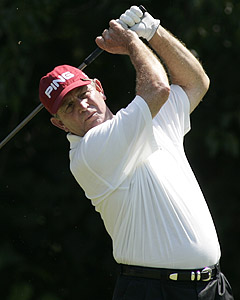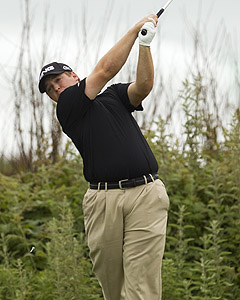Long before he would defeat Bob Jones in the 1926 U.S. Amateur, George Von Elm just wanted to win the Utah State Amateur.
The tournament meant everything to golfers in Utah in those days, and not much has changed. From its founding in 1899 through the 2012 event, the State Am will have been contested for 114 consecutive years as of July, making it the longest continuous golf tournament in the world.
That's an important distinction for Utah, which also will stage its first USGA championship in July when the U.S. Amateur Public Links Championship comes to Soldier Hollow Golf Course in Midway. Opened in 2004, Soldier Hollow, the site for the cross-country skiing and biathlon competitions at the 2002 Winter Olympics, already has become a regular State Am venue.
The State Am is the tournament that has paired brothers against one another, produced father and son champions, showcased a female star, dealt with occasional controversy and just kept going all these years, including when America was involved in World Wars I and II. Its greatest characteristic, longevity aside, is how deeply golfers care about the event and its tradition.
I look at the history of it and the people who have won it, said Bruce Summerhays, the 1966 champion and a three-time winner on the Champions Tour. Utah just has a great history of wonderful players.
Citing the tournament's off-the-charts popularity, USGA Central Region director Mark Passey still marvels about the level of appreciation for the State Am.
It amazes me that the players value this event so highly, to play for pride and prestige, said Passey, a former executive director of the Utah Golf Association.
That level of devotion goes beyond the golfers themselves. If you're wondering why the State Am was played during world wars, when major championships such as the U.S. Open and the British Open were ceasing operations, the answer is both practical and emotional.
 Bruce Summerhays Bruce Summerhays |  Daniel Summerhays Daniel Summerhays |
They did anything to keep it going, to keep that record intact, said Ralph Emery, a longtime golf professional whose father, Al, was the tournament chairman in 1943. They took a lot of pride in that.
The State Am did not begin with Von Elm, but he's a good place to start. Salt Lake City's Forest Dale Golf Course is a modest, nine-hole layout, but it once was the center of Von Elm's golfing universe. Then operated as The Country Club, the course is where Von Elm caddied and shagged balls and developed his game as a teenager.
In 1917, he won the first of his three State Am titles on that course at age 16, launching a legendary amateur career.
His brother, Roy, once said that the experience of winning State Am matches prepared Von Elm for greater challenges, such as taking on Jones in the U.S. Amateur. Von Elm upset Jones in the 1926 final at Baltusrol Golf Club in Springfield, N.J., delivering Jones' only defeat in a five-year period of the championship (Jones won in 1924, 1925, 1927 and 1928, along with 1930). After turning pro, Von Elm also competed in several U.S. Opens, including a runner-up finish in the longest playoff in the event’s history.
Von Elm and Billy Burke were tied after 72 holes in 1931 at Inverness Club in Toledo, Ohio, forcing a 36-hole playoff the next day. When they were deadlocked after the initial 36-hole playoff, the two golfers played another 36 holes when Burke prevailed, 148-149.
Von Elm remains Utah's most distinguished amateur golfer, based on his national achievements, but nobody can match Bill Korns for in-state performance. Despite missing three tournaments during World War II, Korns won six State Am titles in 11 years. Korns might have maintained a winning streak, except that the tournament went on without him. That's partly explained by the fact that sports in Utah generally continued almost as usual during World War II. The University of Utah, for example, fielded a NCAA championship basketball team in 1944, while having to piece together a schedule because some neighboring schools were not competing at the time.
Korns, who died in 2008, once described himself in a Salt Lake Tribune interview as the last of the little, old guys, with a 145-pound frame, a sweet swing and a ton of confidence.
You talk about Tiger Woods; Korns was more confident, Ralph Emery said. He never had a shot he thought he wouldn't hit perfect.
Korns' most valuable club was a Carnoustie putter he bought for 15 cents from a barrel in a Salt Lake City hardware store at age 12 and used for some 30 years. Korns later became a club professional, eventually working at Riverside Country Club in Provo. Having retired, Korns blew out the candles on the cake when the 100th State Am was staged at Riverside in 1998.
Nobody has come close to Korns' record six titles, mainly because so many former winners have turned pro. In the last 50 years, reinstated amateur Doug Bybee is the only three-time winner. Daniel Summerhays came the closest to Bybee, winning in 2000 and '01 and losing in the '06 final.
There's considerable competition for the title of first family of Utah golf, but the Summerhays clans would be tough to beat. The State Am has paired two sets of Summerhays brothers against one another. In 1966, Bruce Summerhays beat his brother Lynn in the semifinals on his way to the title.
The State Am was something I always wanted to win, said Bruce Summerhays, who grew up in Salt Lake City. It really pushed me into wanting to play and knowing I could play really good golf.
The next generation matched Lynn's sons, Daniel and Boyd. Daniel was the defending champion in 2001 at age 17 when he met Boyd in the quarterfinals.
That's the most awkward golf experience I've ever had, said Daniel, a past U.S. Amateur quarterfinalist. Nobody was happy when the match was over, not even me.
Well, the boys' mother was partially pleased. Ann Summerhays said she was as happy and heartbroken as a mother can be.
With his brother's encouragement to make that victory truly meaningful, Daniel went on to win his second title. He's now a second-year member of the PGA Tour, with two top-10 finishes in 2012 and fond memories of the days when merely qualifying for the tournament and reaching match play was a big achievement.
Just talking about it brings back some good feelings, said Daniel Summerhays. Whatever talent I had, that's where it came into fruition.
Summerhays is particularly proud of his second victory, believing that it validated the title he had won on his home course, Oakridge Country Club.
The State Am's most memorable brotherly competition came between twins Craig and Kean Ridd in the 1967 semifinals, a 23-hole duel that Craig won on his way to the title. That's the day sportswriter Joe Watts fell in love with the event he was covering for the first time, eventually leading to his becoming a longtime executive director of the UGA.
The battle was staged in front of the twins' father, Jack, a two-time winner. Jack Ridd's victories came in 1963 and '64. That was a unique, two-year period when the State Am became a stroke-play event.
The Ridd family's victories came within a brief span, in contrast to the Blair's titles. Jimmy Blair (1973) and Zac Blair (2009) each won the State Am in the summer before becoming a Brigham Young University golfer.
Todd Miller, who was in the middle of his BYU career, made the 2004 tournament memorable for reasons other than winning. A son of Johnny Miller, Todd won quarterfinal and semifinal matches on a Saturday to advance to the finals. Rather than play golf on a Sunday, which conflicted with his religious beliefs, Miller announced he would forfeit the match to Clark Rustand.
After some deliberation in the months that followed, the UGA decided to maintain the traditional schedule of a Sunday finish, following stroke-play qualifying on Wednesday and Thursday and two rounds of match play on both Friday and Saturday.
The 2004 event also introduced the first female contestant in tournament history. Awarded a special exemption as the 2002 U.S. Women's Amateur Public Links champion, Annie Thurman Young advanced to match play and won in the round of 32 before being eliminated.
The bulk of State Am entrants must advance through regional qualifying, which was introduced in 1982 in response to the growth of the event's popularity. Previously, any golfers who met the required USGA Handicap Index® were eligible to play at the tournament site. This year, 10 regional events are scheduled in every corner of the state, accommodating as many as 700 to 800 entrants.
The qualifiers will advance to The Country Club of Salt Lake City.
That's the new country club, which opened in 1921, when Von Elm won in his final State Am appearance. More than 90 years later, the 2012 winner will have a connection to Utah's greatest amateur golfer, in the world's longest continuous tournament.
So in a year when a USGA championship is coming to Utah, the State Am will keep going. Watts may be biased in declaring the State Am the greatest tournament in the world, but that widely shared belief in Utah makes the tournament what it is.
Kurt Kragthorpe is a columnist for the Salt Lake City Tribune and was a contributor to the book 100 Years of the Utah State Amateur.

